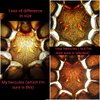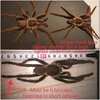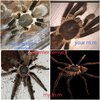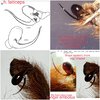Paul Osullivan
Arachnosquire
- Joined
- Dec 18, 2019
- Messages
- 108
Nice, ok yea that does look very similar! The other one did confuse me! That looked a lot like h. crassipes..
I can see many similarities in the sternum of this one! although H. hercules has a flat sternum mound, prehaps there is some debris on the molt? maybe take a close up picture of this area and some more pictures of the spider if possible.. we will get to the bottom of this!


I can see many similarities in the sternum of this one! although H. hercules has a flat sternum mound, prehaps there is some debris on the molt? maybe take a close up picture of this area and some more pictures of the spider if possible.. we will get to the bottom of this!
Attachments
-
1.3 MB Views: 14
-
375.6 KB Views: 21
-
264.5 KB Views: 18










































































